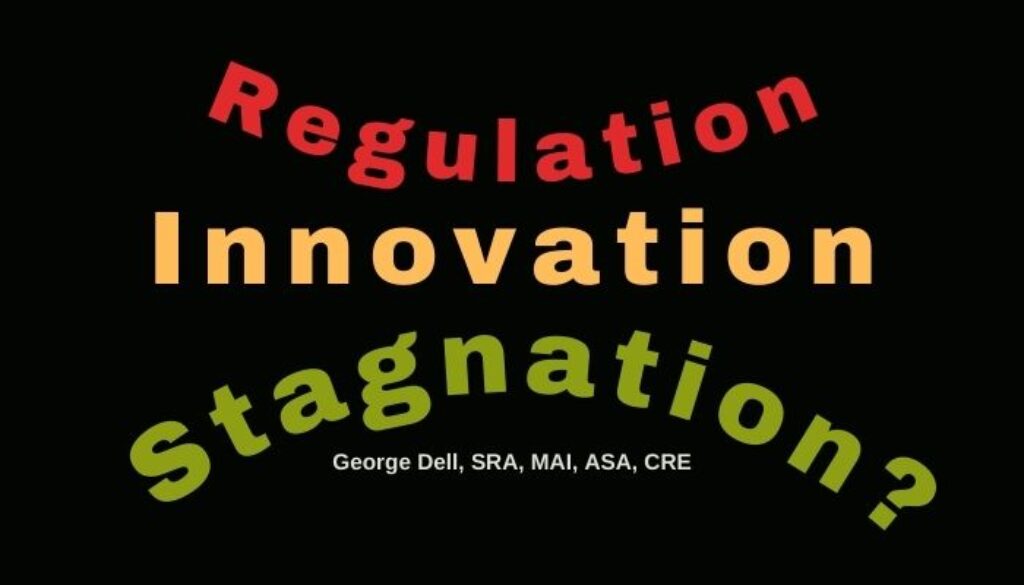Current efforts in the regulation of appraisal quality and fairness are fettered by obsolete appraisal methods. Traditional appraisal methods were designed to tackle sparse, subjective, non-electronic data.
These vintage practices enable bias, hinder diversity initiatives, and conceal risk quantification.
We have written about the “Five Frictions” hindering improvement in regulated appraisal valuation. Most other valuation is performed partly or wholly outside of regulation guidance — such as AVMs, inspectors, evaluations, and ‘acceptance’ policies.
The five frictions comprise: practices, standards, education, regulation, and client expectation. Let’s take a quick look at the nature of these frictions, and how a regulatory overhaul can provide dramatic improvement.
PRACTICES: The ‘old way’ emphasizes subjective ‘picking comps,’ making adjustments, and ‘reconciling’ (justifying inconsistencies) in the data and analysis – provide a perfect single-point answer, an opinion.
The data science way emphasizes:
- objective selection of all relevant market-specific data;
- the probabilistic nature of market information and its analysis;
- visual understanding of market segmentation and calculated results.
Obsolete practices continue due to habit and ‘enforcement’ stemming from the other frictions. Methods not “generally accepted” are verboten (such as econometrics or data science concepts). Such practices continue because “that’s the way we have always done it.”
STANDARDS require appraiser’s scope of work to comply with client expectations (the old way), and what peers do (also the old way). The standards are occasionally re-edited by a group of appointed appraisers, highly trained in the ‘established’ way of doing things.
Standards require appraisers to “employ those recognized methods and techniques.” [Emphasis added.] Note that any currently available or technologically superior methods are not ‘recognized’ under these rules – even as they may be prevalent elsewhere. Recognized methods comprise the three approaches, but exclude the robust data science approach.
EDUCATION is enforced by states, which must ‘approve’ any qualifying continuing education in timed outline form. Short-handed staffs, or non-appraisers, or traditionally trained appraisers must approve any curriculum – which must comply with the recognized methods. Any innovation or improvement is problematic as there are no qualified personnel to approve or evaluate new superior methods.
Old education tends to be linear and prescriptive, emphasizing appraiser credibility (believability), rather than analytical reliability. Data science is a wholistic integrated approach. It optimizes the best of human expert judgment and computer algorithms.
The data science approach connects directly to modern bank “fintech” tools, thus clarifying bank regulation policy decisioning. Policy issues include bank procedural audit, valuation review/audit standards, and portfolio/risk management. What is needed is measurable results. Measurability, accuracy, and confidence scores are made possible with Evidence Based Valuation. Data science objectivity is motivated and long-term assured with the proper regulatory goals.
Continued teaching of judgment-based data selection, adjustments, and reconciliation undermines every other public and private goal.
CLIENT EXPECTATION itself is subject to the appraisal “users’ expectations” rule, and bank laws and practices, and GSE “guidelines.” Clients use appraisers and reviewers steeped in traditional, judgment-based philosophy. Insistence on good ethics helps. Requiring measurable reliability solves problems.
REGULATION may be the only answer to effective reform. Effective government, the public trust, and the appraisal profession demand this sweeping reform. We need the daylight of Evidence Based Valuation (EBV©). We need analytic results — in place of licensed opinion.
The five frictions feed off and reinforce each other. Stagnation is the result.
SUMMARY: Standards are wholly subjective, and do not have reliability as a goal. States attempt to (administrative law) enforce vague, undefined “violations” which do not exist in USPAP. Meanwhile, competitors to appraisal services — have no licensing, no standards, and no direct accountability to public responsibility.
So long as the other five forces of friction remain in place, innovative education and enlightened asset assessment will not happen. Change must come from streamlined encouragement of modern methods, not methods designed for data and the mentality of 50 years ago.
